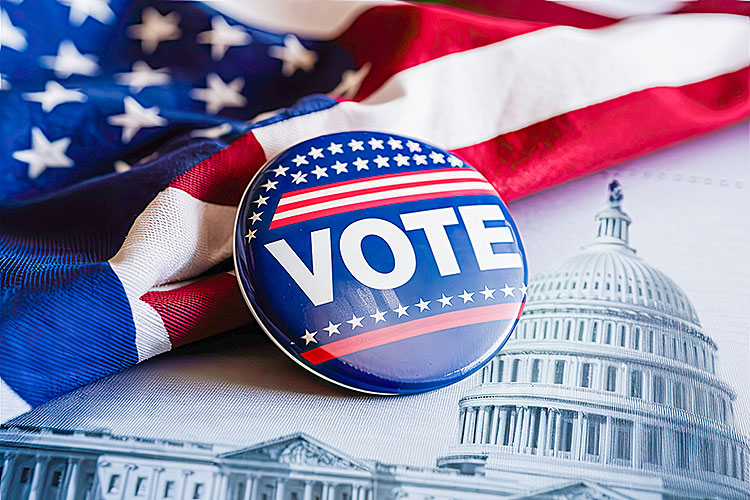By Andrew Goldenkranz
Since Election Day, half the country is going through the stages of grief and half are celebrating. We are a deeply divided nation and that is an inescapable truth. But it’s not enough to write off the national results as voters succumbing to hate or being deceived. The people have spoken, but what are they saying?
As a local representative of the Democratic Party, I have to be honest about what went right and wrong and how we chart a path forward. Like a coach after the game, win or lose, you watch the film, crunch the numbers, and try to figure out how to do better. This piece is not about the important policy or legislative battles that will ensue, but about voting behavior, campaign mechanics, and a growing generational realignment of party affiliation and preference. I’ve been doing this for more than 40 years, so am not an expert but I’ve had plenty of practice!
Even in deep blue California, there was an 8-point swing from 2020 to 2024. That’s a lot. I’ve been reading progressive media and listening to local friends who wash their hands and claim that half the country is racist, sexist, or stupid. I’m not buying that. During the campaign, I spent some time in Pennsylvania in some of the purple ring counties around Philadelphia, and locally we sent more than 125,000 hand-written letters and postcards to Georgia and other swing states. But It’s hard coming from our college town coastal perspective to see what’s going on in the rest of the country.
In no particular order, here’s my take on some of the key elements of this election result:
1) This was a Democratic loss more than a Republican win.
Trump got about the same 75-76 million votes he did in 2020, but Harris got 6 million fewer votes than Biden.
2) The race was a lot closer than you think.
From over 150 million votes cast, Trump ran the 7 swing states by a total of about 250,000 votes. That’s an improbable comeback but not the mandate or landslide some claim.
But it was a decisive win. I make this point not to minimize the consequences of the result, but to point out that in a big country, this race carried on small margins.
So if each of the following elements accounted for a 20,000 vote difference, it adds up.
My argument is it was more likely a lot of little things rather than one big thing.
3) Coattails are weaker than they used to be.
There were 4 states Trump carried where pretty progressive Democrats got elected: Wisconsin, Michigan, Arizona, and Nevada. A generation ago, more than half of voters voted a straight party line ticket, this time it was about ⅓ of voters.
John Tester, Sherrod Brown, Colin Allred, and Bob Casey, good people and candidates, were not sufficient to overcome the trends I”m discussing here.
4) The women’s reproductive rights/abortion rights linkage to Harris may have backfired and was certainly not as strong as we thought it would be.
In Arizona, for example, 61% of voters approved enshrining reproductive rights into their constitution. But Harris only got 47% of the vote. This means 14% of voters support reproductive freedom but still voted for Trump.
There’s a quieting of cognitive dissonance on this point, where people are reconciling these apparently contradictory votes. It could be a reliance on states’ rights; it could be these voters are multi-issue voters.
But while I’m encouraged about 70% of the country strongly supports abortion rights, it was not enough to create a reverse coattail.
5) There’s a real demographic realignment where working class voters, black and brown male voters, and young voters (especially young men) shifted right.
I think this is not a fluke, but a larger trend. Let’s break this down:
5a) Some Black voters have seen the erosion of the Voting Rights Act, the end of affirmative action, and other inactions in the last decade or so, and are naturally concluding the government has let them down. So they were motivated by a change agent who was going to break things.
5b) Working people have seen an incredible surge in wealth at the top of the economic ladder over the last 40 years, while middle class wage earners are working harder and harder for nominal gains. And prices, especially housing prices, are increasingly out of reach. So when Harris’s loyalty to Biden required that she declare the Inflation Reduction Act, the CHIPS Act, the American Recovery Act, and other big ticket items as obvious victories, about 25% of working class voters were not sold.
We underestimated the inflation pressure on people, especially in housing and food, and spent more time quoting statistics rather than feeling people’s pain.
5c) Young voters showed a similar distrust in government. The Biden administration talked a good game about eliminating student debt, but was not able to fully implement it because of court objections. Harris came late to the game with a solid proposal about first time homebuyer assistance, but it was a late promise didn’t gain enough traction. In 2020, Biden won the under 35 vote by 20 points, and the Harris campaign was targeting a 30 point spread among young women. Instead, female voters under 35 preferred Harris by 20 points, while under-35 males preferred Trump by 10. This is a 10 point swing among young voters.
6) For infrequent voters, we Democrats underestimated the power of show business.
I think part of this is Trump’s crazed marketing genius. My students were very happy to talk about Hulk Hogan’s appearance. Young voters especially, but also low-frequency voters of all ages, were mesmerized by the show. As one of my students (not a Trump fan) told me, “Of course he won. In America, the Kardashians are our royal family. What did you think was going to happen?”
7) We got a false optimism by the crush celebrity endorsements.
Don’t get me wrong, I”m very happy Taylor Swift, Beyonce, Oprah, Eminem, and others endorsed Harris and they were surely helpful in raising money. But I did not see an operational translation of that energy to messaging voters. n
8) Fracking and the Israel/Gaza/Hezbollah conflict put Harris in a very difficult position where her centrist position alienated people on both sides.
8a) In Michigan, where there’s both a sizeable Muslim and Jewish population, there was a dropoff in presidential voting from two constituencies that are traditionally strongly Democratic. Some patriotic Jewish voters were concerned Harris was not sufficiently supportive of the Netenyahu government, and about 10% of Muslim and Arab American voters simply did not vote for president as a protest vote. Remembering this race was decided at the margins, those are noticeable results.
8b) In Pennsylvania, where fracking for natural gas is king, Harris was unable to convince voters with her declarations that she would not ban fracking. Navigating a just transition to a clean energy economy is one of the most important issues of our time, but it’s hard and the details are important. A simple slogan like “drill baby drill” spoke louder for about 15% of Pennsylvania voters than the intricacies of job creation and carbon emissions.
9) Fareed Zakariah has written extensively of a generational realignment from the union/senior/civil rights backbone of the Democratic Party to an electorate fractured by education.
Voting increasingly trends more liberal with more education. The challenge for Democrats is to engage in real conversations with non-college grad voter without coming across as smug, superior, coastal elites.
10) Polls consistently over almost a decade show the hard-right, MAGA, burn it down part of the GOP electorate is about 30 million people.
They’re not going away and show no signs of slowing down. We have to accept this is fact.
11) We had lots of campaign workers out there canvassing, and sent unprecedented numbers of volunteers to Arizona and Nevada from our local area.
During my time in Pennsylvania, I worked in the most organized and sophisticated campaign operation I’ve ever seen. But here’s the problem. We spent more time pushing flyers and texts than actually talking with voters. Our message was more often “How can you possibly vote for guy?” rather than “what motivates you to lean towards him?”
There’s a growing movement of “relational organizing” that stresses developing relationships and deeper conversations, but in the heat of a campaign, the emphasis is still on volume. Knocking and dropping on 200 doors can be done in the same time it takes to have 15 or 20 actual conversations. This effort can’t just be seasonal, it has to be an everyday activity.
12) Back of the brain politics can work.
Trump’s appeal to rage, anxiety, and fear resonated with many voters’ concerns. We are experiencing the first generation of young people who feel like the American Dream of homeownership and a doing better than their parents is a myth.
Brain science teaches us the back of your brain, where fear and the fight/flight triggers live, operates about 100 times faster than the front of our brain, where logical reasoning, empathy, and hope live. It doesn’t mean we have to give into this, but need to understand that it’s not an even choice. Our brains pull us in that direction naturally.
13) Other quality candidates count.
In Georgia, for example, Rafael Warnock, a charismatic, articulate, quite lovable figure, was on the ballot in 2020 and 2022 and led the victories there. While he was present as a spokesperson, his absence from the ballot caused a dropoff in voting including the historic “souls to the polls” tactic used so successfully for early Sunday voting.
14) Trump successfully conflated concerns about crime with concerns about immigration, which is not an evidence-based argument.
But the Democratic response of “it’s not really that bad” or “the GOP killed a solid border bill” was not sufficient either on the clarity of the policies or on the emotions that follow these issues.
•••
Bottom line? We have work to do to rebuild. As my mom used to tell me, “you were born with two ears and only one mouth. Use them in that proportion.” The Democratic comeback begins with listening and not waiting until the last minute. Early organizing is the best kind of organizing.
•••
Andrew Goldenkranz, a career public educator, is the chair of the Santa Cruz County Democratic Party.

